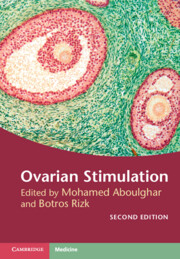Book contents
- Ovarian Stimulation
- Ovarian Stimulation
- Copyright page
- Dedication
- Contents
- Contributors
- About the Editors
- Foreword
- Preface to the first edition
- Preface to the second edition
- Section 1 Mild Forms of Ovarian Stimulation
- Chapter 1 Oral Agents for Ovarian Stimulation
- Chapter 2 Ovulation Induction for Anovulatory Patients
- Chapter 3 Ovarian Hyperstimulation in Combination with Intrauterine Insemination
- Chapter 4 Mild Approaches in Ovarian Stimulation
- Chapter 5 The Case against Mild Stimulation Protocols
- Section 2 Ovarian Hyperstimulation for IVF
- Section 3 Difficulties and Complications of Ovarian Stimulation and Implantation
- Section 4 Non-conventional Forms Used during Ovarian Stimulation
- Section 5 Alternatives to Ovarian Hyperstimulation and Delayed Transfer
- Section 6 Procedures before, during, and after Ovarian Stimulation
- Index
- References
Chapter 3 - Ovarian Hyperstimulation in Combination with Intrauterine Insemination
from Section 1 - Mild Forms of Ovarian Stimulation
Published online by Cambridge University Press: 14 April 2022
- Ovarian Stimulation
- Ovarian Stimulation
- Copyright page
- Dedication
- Contents
- Contributors
- About the Editors
- Foreword
- Preface to the first edition
- Preface to the second edition
- Section 1 Mild Forms of Ovarian Stimulation
- Chapter 1 Oral Agents for Ovarian Stimulation
- Chapter 2 Ovulation Induction for Anovulatory Patients
- Chapter 3 Ovarian Hyperstimulation in Combination with Intrauterine Insemination
- Chapter 4 Mild Approaches in Ovarian Stimulation
- Chapter 5 The Case against Mild Stimulation Protocols
- Section 2 Ovarian Hyperstimulation for IVF
- Section 3 Difficulties and Complications of Ovarian Stimulation and Implantation
- Section 4 Non-conventional Forms Used during Ovarian Stimulation
- Section 5 Alternatives to Ovarian Hyperstimulation and Delayed Transfer
- Section 6 Procedures before, during, and after Ovarian Stimulation
- Index
- References
Summary
Worldwide intrauterine insemination (IUI) is still one of the most applied treatment options for couples with infertility for various reasons. The rationale for performing IUI is to increase the number of motile sperm with normal morphology at the site of fertilization at the right moment. With the use of sperm preparation techniques applied in in vitro fertilization (IVF), side effects such as severe cramping or infections hardly ever occur any more.
- Type
- Chapter
- Information
- Ovarian Stimulation , pp. 29 - 35Publisher: Cambridge University PressPrint publication year: 2022



